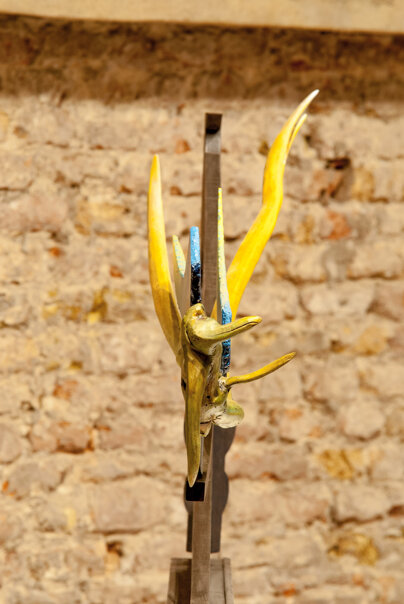® Copyright 2025 | ART RAMPIN FRANCESCO | Tutti i diritti riservati.

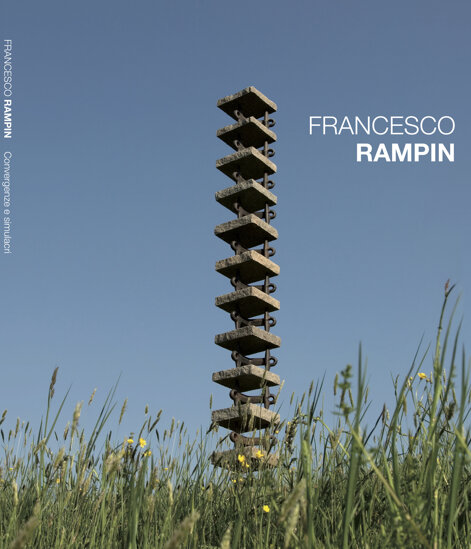
CONVERGENZE E SIMULACRI
FRANCESCO RAMPIN
DETTAGLI
Autore | FRANCESCO RAMPIN
Curatore | ARCH. MATTEO RAMPIN
Anno edizione | 2011
In commercio Luglio 2011
Pagine | 110 p., ill. , Rilegato
2011 | FRANCESCO RAMPIN | CONVERGENZE E SIMULACRI - Padova “Oratorio San Rocco”
Tra gli aspetti che appaiono sempre più evidenti nella produzione artistica di Francesco Rampin si palesa una predisposizione ad una sintesi formale che regola i dati di superficie e volume a partire da una sequenza logica riduttiva, ragionata in una sua corretta dislocazione nella luce.
Nella loro massima semplificazione, le opere qualificano pertanto uno spazio nuovo, definito da un rapporto proporzionato tra stabilità e ritmo, colore e luce, forma e significato.
Organizzate secondo una consequenzialità di rapporti primari, tali configurazioni si collocano dunque con un vigore spaziale che ne amplia e ne potenzia i contenuti, tanto a livello stilistico quanto a livello metaforico.
Il fatto di insistere in una combinazione di elementi organici e artificiali suggerisce l’attenzione riposta dall’artista allo studio del materiale: l’intento è quello di concepire forme nuove, non riconducibili a modelli preesistenti, quanto piuttosto suggerite dalle caratteristiche proprie della materia.
Pertanto, elementi industriali di scarto, ormai consumati dall’usura, si combinano, in una luce nuova, a materiali tradizionali come pietra, marmo e legno, raggiungendo formule espressive che sintetizzano tradizione – intesa nel recupero delle tecniche dell’incidere e del saldare – e simboli meccanici della civiltà moderna.
L’intervento da parte dell’artista è del resto pressochè minimo, nel rispetto delle irregolarità e delle ruvidità del materiale, il che, potenzialmente, assume una connotazione specifica anche da un punto di vista immaginativo, poiché suggerisce, nel pensiero dell’artista, un nesso tra elementi naturali e derivati di origine industriale, vale a dire implicazioni di ordine emotivo e spirituale dettate dall’unione (o dalla contrapposizione) di ciò che è della natura con ciò che deriva dall’artificio.
Sono questi, da un punto di vista materico, i due poli tra i quali si muove il pensiero di Francesco Rampin, suggestionato dal mutamento continuo dell’originario combinato, o rinnovato che dir si voglia, dall’industrializzato. (Trampolino, 20..)
Per questo motivo, poiché aderiscono alla realtà non soltanto mediante espedienti di ordine imitativo, tali figurazioni custodiscono in sé una pluralità di significati e di valenze fortemente simboliche, esibendosi quasi come idoli o totem divinatori rappresentanti la dimensione temporale dell’uomo.
Sono infatti opere in cui il confine tra la figura e la sua riproduzione è volutamente rarefatto: non si tratta di riecheggiare le forme oggettuali della natura, né di riprodurle per mezzo di equivalenti artistici, quanto piuttosto di tradurne, nel modo più semplificato possibile, le complessità ed i rapporti interni.
Tant’è vero che, in gran parte delle opere di Francesco Rampin, si percepisce un senso di enigmaticità, di allusione e di piacevolezza estetica tale da legittimarne l’importanza a livello plastico e concettuale. (Il custode del tesoro, 20..)
Oltre a quanto detto, si percepisce nell’artista l’ambizione a creare opere di grandi proporzioni: la forma volumetrica, ingigantita, è in grado di confrontarsi e dialogare idealmente con le forme della natura, evidenziando in maniera inequivocabile il proprio contenuto primario di ordine ascensionale, ossia di transito dallo stato di concretezza fisica a quello di idealità spirituale. (Totem d’Oriente, 20..), (Omaggio a Brancusi, 20..)
Di pari passo, l’esito finale discende in forte misura dal supplemento cromatico, e non a caso queste forme spaziali, dipinte con colori a spruzzo, sono conseguenti a una prima origine pittorica dell’artista.
L’intensità dinamica delle tinte, quasi sempre caricate oltre il naturale di contro all’essenzialità del materiale stesso, insiste sulla componente artificiosa dell’opera e insieme ne rinvigorisce l’efficacia plastica, favorendone nuove connessioni spaziali; allo stesso modo la luce assume un ruolo cruciale nel modularne l’equilibrio formale e compositivo.
All’interno di questa meditazione sulla complessità delle forme, vale la pena sottolineare, unitamente ad un controllo plastico – spaziale rigoroso e ad un uso oltremodo razionale dei procedimenti tecnici, l’atteggiamento sostanzialmente autonomo di Francesco Rampin.
La sua è essenzialmente la ricerca di una nuova direzione artistica, di un linguaggio non standardizzato, delineato a tratti essenziali e altamente simbolico, in grado di riunire scelte formali e significato spirituale in un’unica composizione.
Questo richiamo ad un significato più intrinseco delle immagini e ad una negazione delle apparenze esteriori in quanto tali caratterizza tuttora il percorso artistico di Rampin, scultore di strutture multiformi, allegoriche, talvolta apparentemente contradditorie, ciò nondimeno sorrette da un principio di indipendenza e semplificazione formale imprescindibile.
2011 | FRANCESCO RAMPIN | CONFLUENCES AND IMAGES - Padova “Oratorio San Rocco”
Among more aspects, appearing in Francesco Rampin’s artistic production, there is a natural bent for a formal synthesis which rules the signs of surface and volume using, as a sort of first step, a narrow logical sequence; in turn, it is reasoned in its right distribution in the light.
In their main simplification, the works therefore characterize a new space, which is defined by a proportioned relationship between stability and rhythm, colour and light, shape and meaning.
Hence, these shapes are organized according to a consequentiality of primary relations and they place themselves with a space vigour which increases and develops the contents, both in a stylistic and metaphoric way.
The fact of persisting in a combination of organic and artificial elements suggests the attitude of the artist for what concerns the study of matter: his purpose is to think about new forms which do not refer to pre-existent models but recall to memory the specific features of the same matter.
Then industrial rejected elements, now worn by wear and tear, combine themselves, in a new light, with traditional materials, such as stone, marble and wood, reaching expressive forms which synthesize tradition and mechanical symbols of modern civilization. Of course, the concept of tradition refers to the reutilization of carving and soldering techniques.
The artist’s participation is almost very little, with respect to the irregularity and roughness of matter; this behaviour takes a specific connotation, also according to a creative point of view, because it implies a relation between natural and industrial elements, inside the artist’s thought. In other words, there are emotional and spiritual implications , which are suggested by the union (or by the contrast) of what belongs to nature with what derives from artifice.
Considering the matter, Francesco Rampin’s reflection exactly mouves between these two poles; he is influenced by the continuous change of the originary objects, which are arranged, or renewed, by the industrialized processes (Springboard, 2009).
For this reason, those representations keep in their own essence a variety of meanings and strongly symbolic values, because they agree to reality not only using imitative devices; they show themselves as idols or prophetic totem, which represent the temporal dimension of mankind.
In fact, in his works the boundary between figure and its reproduction is consciously rare: the artist does not evoke the object shapes of nature, nor does not he reproduce them using artistic equivalents. He wants to translate, in a very simple way, their complexity and inner relations.
Actually, in many Francesco Rampin’s works, you can perceive a sense of mystery, hint and aesthetic delightfulness, so that it can justify the plastic and conceptual importance of his sculptural installations (Keeper of the treasure, 2007).
In addition to what already told, there is the ambition to create works of great dimensions in the artist’s spirit: the magnified volumetric form is able to face each other and to talk ideally with nature’s shapes, highlighting, in an unequivocal way, its own primary content of upward order, that is to say of passage from a state of physical concreteness to a state of spiritual ideality (Totem of the East, 2008; Homage to Brancusi, 2010-2011).
At the same rate, the final result descends, to a large degree, from a chromatic addition, and, in fact, these spatial forms, which are painted with spray colours, are consequent to a first pictorial origin of the artist.
The dynamic intensity of shades is nearly always emphasized beyond the natural as opposed to the essentiality of the same matter; besides, it insists on the artificial component of the work and together it revives its plastic efficacy, supporting new spatial connections; similarly the light has a crucial role in modulating the formal and compositional balance.
Inside this meditation about the complexity of forms, it is useful to underline the substantially free attitude of Francesco Rampin, together with a rigorous plastic-spatial control and an extremely reasoning use of technical processes.
Essentially Rampin’s research mouves towards a new artistic direction; it implies the discovery of a language which is not standardized but is defined using essential and highly symbolic features, able, inside an only composition, to put formal choices and spiritual meanings together.
This call to an innerer meaning of the images and to a negation of the right exterior appearances characterizes still now Rampin’s artistic way. For this reason, Rampin is a sculptor of many-sided allegoric structures, which are seemingly contradictory sometimes but are sustained by a principle of independence and unescapable formal simplification.
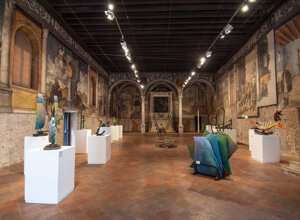
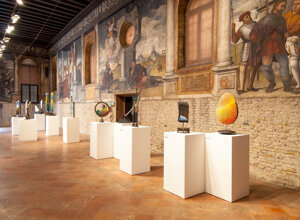
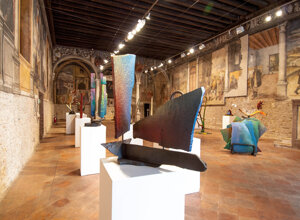
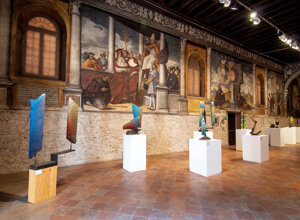
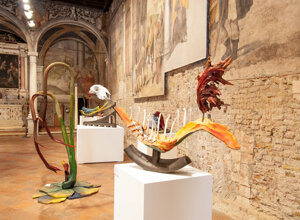
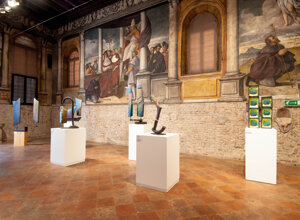
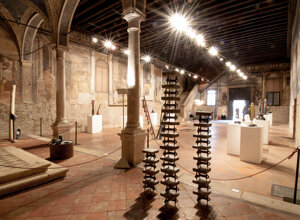
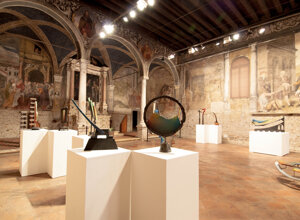
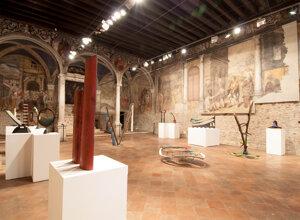
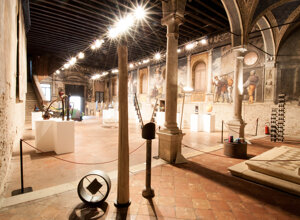

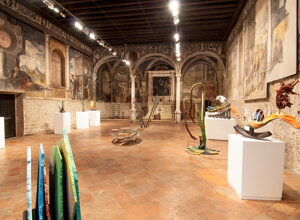
Francesco Rampin
che lavora il porfido
e lo annette con il colore
ai paesaggi della pittura
la sua mano ha il sogno geologico
che ha sollevato sul mare le montagne
chi affida alla pietra
i suoi pensieri
sta sui confini dell’eternità
perché la pietra non muore
si è confrontata nel tempo
con la fucina dei vulcani
e i diluvi periodici delle acque
che sono stati gli scalpelli invisibili
che hanno sbozzato nei massi delle fisionomie
Francesco Rampin
sa leggere nei fossili
la leggenda delle ere
sa mettere in equilibrio delle rocce
divinando il loro segreto baricentro
è un artista di scienza e di potenza
i suoi pollici premono sulla pietra
con la persuasione del vento
per lui ogni ciottolo ha un’anima
e le rocce
sono l’altare di un’arte
che si erge nel cielo
come un totem.
Giorgio Celli
Francesco Rampin
who moulds porphyry
and encloses it
to the landscapes of painting
using colour
his hand has the geologic dream
which raised the mountains over the sea
the one who commits his inner thoughts
to the stone
finally sits on the eternity’s boundaries
because the stone never dies
it faced during the time
volcanoes’ forge
and periodic flood of water
they were the invisible chisels
which roughed out some features on the rocks
Francesco Rampin
can read the legend of the ages
inside the old fossils
he can balance stones and rocks
while he divines their secret centre of gravity
he is an artist of science and power
his thumbs press on stone
with the same persuasion of the wind
for him each pebble has a soul
and the rocks
are the altar of an art
which rises over the sky
like a totem.
Giorgio Celli
